What’s Up?
Clemens and I enjoyed one last, short session by boat on Lake Kissimmee. We used the public ramp at Coleman Landing at Shady Oaks, about 15 minutes from my home. The day began as cloudy-dark and ended when it began to rain at about 9:00am. Snail Kites were hard to come by. My favorite image was a 1/8-second blur of an Osprey braking to land. After dropping me off at home, Clemens headed home with the boat in tow.
IPT veteran and good California friend Ed Dow and Toni, his significant other, stopped by for a late-afternoon pool-deck lunch followed by a tour of “down-by-the-lake.” For the first time in a week both eagles were at the nest tree. Ed and Toni left and headed for Fort DeSoto (where Ed attended his first IPT). I am anxious to hear how he does.
After several days of photo-recreation, I will get back to work today on the first and only update of the BAA R5/R6 AF e-Guide and the BAA Canon EOS R5 Camera User’s e-Guide. I learned a lot about my R5 on the boat and my writing will reflect what I learned.
I was glad to learn yesterday that the sale of Bill Schneider’s Sony Alpha a9 ii became final, as did the sale of Robert Kimbrell’s Sony Alpha a7r iv and Craig Mossey’s Sony Alpha a9.
Today is Sunday 14 February 2021. When I woke at 5:00am — a bit on the late side for me, it was pouring rain. The rain stopped quickly and the forecast for this morning is for clouds with winds from the south. I will be heading down to the lake for a bit.
This post took about 2 hours to prepare and makes fifty-seven days in a row with a new one. Please remember…
Please Remember
With income from IPTs now at zero, please, if you enjoy and learn from the blog, remember to use one of my two affiliate programs when purchasing new gear. Doing so just might make it possible for me to avoid having to try to get a job as a Walmart greeter and will not cost you a single penny more. And if you use Bedfords and remember to enter the BIRDSASART code at checkout, you will save 3% on every order and enjoy free second-day air shipping. In these crazy times — I am out at least forty to sixty thousand dollars so far due to COVID 19 (with lots more to come) — remembering to use my B&H link or to shop at Bedfords will help me out a ton and be greatly appreciated. Overseas folks who cannot order from the US because of import fees, duties, and taxes, are invited to help out by clicking here to leave a blog thank you gift if they see fit.
Canon R5/R6 AF e-Guide Info
So far, 112 folks have sent PayPals for their copy of the Canon R5/R6 AF e-Guide. And 37 who used my affiliate links to purchase their R5 have e-mailed for and received their free copy of the guide. If you e-mailed your Bedford receipt or sent a PayPal and did not receive your guide, please LMK immediately via e-mail.
Feedback on the guide continues to be overwhelmingly positive. Please scroll down to read about the BAA Canon EOS R5/R6 User’s e-Guide. Note that the info in the BAA Canon R5/R6 Autofocus e-Guide is so important that I opted to publish the AF guide immediately as the R5/R6 User’s Guide will take about another month to finish (or hopefully less).
|
|
BAA Canon R5/R6 Autofocus e-Guide |
BAA Canon R5/R6 Autofocus e-Guide
Twenty-one pages. 3,452 words. 28-DPP4 screen captures showing the R5’s vaunted AF system in action. Note: the AF system of the R5 is identical to the AF system of the R6.
You will learn:
1- The two most useful AF Methods for general bird photography and for birds in flight.
2- How to set up your R5/R6 AF Menus.
3- What boxes to check (and un-check) under Limit AF Methods.
4- How to change the AF Method quickly, easily, and efficiently. Note: the default way of doing this is clunky, cumbersome, and inefficient at best. One person replied that this tip alone was worth the price of admission.
5- The only setting that should be used for Initial Servo AF pt for Face Detection + Tracking.
I you are currently using multiple back buttons either for general bird photography or for birds in flight, what you learn in this guide will change your life. For the better.
Here are the first three paragraphs of this e-Guide:
From the moment I learned about the new Canon mirrorless bodies, I read about using two or three back-buttons to focus using different AF methods. The word on the street said that the way to go for birds in flight was to use one button to acquire focus with Zone AF or with Large Zone: Horizontal AF and then switch to another button to activate Face Detection + Tracking AF and then use the shutter button to make an image. My immediate thought was, “This is insanity! There has got to be a better way.” In short, there is a far superior way to set up AF on your R5 or R6.
Remember that I got away from any form of back-button or rear focusing many years ago after finally realizing that it is always easier to do one thing (press the shutter button), than it is to do two things (press a back button and then press the shutter button).
The default method of switching AF Methods with the R5/R6 bodies is cumbersome at best. It involves first pressing the grid button (my name) on the upper right back of the camera and then pressing the hard-to-access M-Fn button to toggle through the AF Methods. This method is so bad that it will not be mentioned again in this guide.
The guide is free to all who have ordered an R5 or an R6 using my B&H affiliate link or from Steve Elkins/Bedfords using the BIRDSASART coupon code at checkout. Please send your receipt to me via e-mail. It will take me a few days to a week to verify the B&H purchases. Bedfords folks should expect their free e-Guides fairly quickly.
To purchase your copy of the e-Guide, please click here or send a PayPal for $25.00 to birdsasart@verizon.net and be sure to include the words R5/R6 AF Guide in your PayPal e-mail.
Everyone who gets the guide will receive a free update no later than the third week of February.
Canon EOS R5 Camera User’s e-Guide
As regular readers know, I am working on a complete BAA Canon EOS R5 Camera User’s e-Guide. Because the camera and the Menus are so complex, this will require a lot of research, a lot of time, and a lot of effort. I am hoping to have it complete by late February. As always, folks who use the BAA affiliate links to purchase their Canon gear will receive a substantial discount. Once I send out the updated R5/R6 AF e-guide, it will become part of the complete Camera User’s e-Guide.
|
|
RawDigger e-Guide with Two Videos |
The RawDigger e-Guide with Two Videos
by Arthur Morris with Patrick Sparkman
The RawDigger e-Guide was created only for serious photographers who wish to get the absolute most out of their raw files.
Patrick and I began work on the guide some time in July 2020. At first we struggled. We asked questions. We learned about Max-G values. We puzzled as to why the Max G values for different cameras were different. IPT veteran Bart Deamer asked lots of questions that we could not answer. We got help from RawDigger creator Iliah Borg. We learned. In December, Patrick came up with an Adapted Histogram that allows us to evaluate the exposures and raw file brightness for all images created with all digital camera bodies from the last two decades. What we learned each time prompted three head-to-toe re-writes of the guide.
The point of the guide is to teach you to truly expose to the mega-Expose-to-the-Right so that you will minimize noise, maximize image quality, best utilize your camera’s dynamic range, and attain the highest possible level of shadow detail in your RAW files in every situation. In addition, your properly exposed RAW files will contain more tonal information and feature the smoothest possible transitions between tones. And your optimized images will feature rich, accurate color.
We teach you why the GREEN channel is almost always the first to over-expose. We save you money by advising you which version of RawDigger you need. We teach you how to interpret the Max G values for your Canon, Nikon, and SONY camera bodies. It is very likely that the Shock-your-World section will shock you. And lastly — thanks to the technical and practical brilliance of Patrick Sparkman — we teach you a simple way to quickly and easily evaluate your exposures and raw file brightness using an Adapted RawDigger histogram.
The flower video takes you through a session where artie edits a folder of images in Capture One while checking the exposures and Max-G values in RawDigger. The Adapted Histogram video examines a series of recent images with the pink histograms and covers lots of fine points including and especially how to deal with specular highlights. The directions for setting up the Adapted Histogram are in the text.
If we priced this guide based on how much effort we put into it, it would sell it for $999.00. But as this guide will be purchased only by a limited number of serious photographers, we have priced it at $51.00. You can order yours here in the BAA Online Store.
Great Topaz News!
Folks who use the BAA Topaz link to purchase Sharpen AI, DeNoise AI, or the Utility Bundle (or any other Topaz plugins) will receive a 15% discount by entering the ARTHUR15 code at checkout. If the stuff is on sale (as it usually is), you save 15% off of the sale price! To get the discount you must use my link and you must enter the discount code. Be sure to start with this link.
Those who purchase Sharpen AI, DeNoise AI, or any other Topaz plug-ins using my link and then entering the ARTHUR15 code at checkout can e-mail to request a short Getting Started with Topaz e-Guide. Please include a copy of your Topaz receipt that shows the discount. Aside from the basics, the guide explains how to install the plug-ins so that they appear in the Photoshop Filter Menu.
New and Better Bedfords Discount Policy!
You can now save 3% on all of your Bedfords photo gear purchases by entering the BIRDSASART coupon code at checkout. Your discount will be applied to your pre-tax total. In addition, by using the code you will get 2nd day air shipping via Fed Ex.
Grab a Nikon AF-S Teleconverter TC-14E III and save $14.99. Purchase a Canon EOS R5 and your discount will be $116.97. Purchase a Sony FE 600mm f/4 GM OSS lens and save a remarkable $389.94! Your Bedford’s purchase no longer needs to be greater than $1,000.00 for you to receive a discount. The more you spend, the more you save.
Money Saving Reminder
Many have learned that if you need a hot photo item that is out of stock at B&H and would enjoy free second-day air shipping, your best bet is to click here, place an order with Bedfords, and enter the coupon code BIRDSASART at checkout. If an item is out of stock, contact Steve Elkins via e-mail or on his cell phone at (479) 381-2592 (Central time). Be sure to mention the BIRDSASART coupon code and use it for your online order to save 3% and enjoy free 2nd-day air shipping. Steve has been great at getting folks the hot items that are out of stock at B&H and everywhere else. The wait lists at the big stores can be a year or longer for the hard to get items. Steve will surely get you your gear long before that. For the past year, he has been helping BAA Blog folks get their hands on items like the SONY a9 ii, the SONY 200-600 G OSS lens, the Canon EOS R5, the Canon RF 100-500mm lens, and the Nikon 500mm PF. Steve is personable, helpful, and eager to please.


Gear Questions and Advice
Too many folks attending BAA IPTs (remember those?) and dozens of photographers whom I see in the field and on BPN, are–out of ignorance–using the wrong gear especially when it comes to tripods and more especially, tripod heads… Please know that I am always glad to answer your gear questions via e-mail. Those questions might deal with systems, camera bodies, accessories, and/or lens choices and decisions.
|
|
|
This image was created on 13 February 2021 at Lake Kissimmee, FL. Working from Clemens Van der Werf’s boat, I used the handheld Canon RF 100-500mm f/4.5-7.1L IS USM lens with the Canon Extender RF 1.4x (at 700mm) and the highly touted 45MP Canon EOS R5 Mirrorless Digital camera body. ISO 5000. Exposure determined by test image histogram evaluation and confirmed as near-perfect by RawDigger: 1/500 sec. at f/10 (wide open!) in Manual mode. AWB at 8:37am on cloudy dark overcast morning. Face detection + Tracking/AI Servo AF was active at the moment of exposure and performed perfectly. Click the image to see a larger version. Image #1: Snail Kite young male |
ISO 5000 Image Quality
While today’s featured ISO 5000 image is fine for web presentation and other electronic uses, it is lacking in fine feather detail; overall I would rate the image quality as fair. Of the few Snail Kites that we saw, this one was the most cooperative. He seemed totally unaware of the boat. We could not, however, get any closer because of the thick mats of freshwater vegetation. So I added the teleconverter mainly to see how the AF worked. With the prime lens wide open at f/7.1 at the long end, adding the teleconverter gets you to F/10.
Those with the 100-500 must remember that they need to zoom to at least 300mm or they will not be able to mount the RF 1.4X teleconverter. In the same vein, once the TC is mounted, you will not be able to zoom wider than the 300mm setting. Your 100-500mm lens becomes a 420 to 700mm lens. Its versatility suffers.
|
|
|
Click the image to see a larger version so that you can see the red AF square right on the bird’s face. Image #1A: DPP 4 screen capture for the Snail Kite young male image |
R5 Firmware Update Version 1.2.0
Working with 100-500 with the RF 1.4X teleconverter in place, the R5’s Face detection + Tracking/AI Servo AF (with Animal Eye) worked perfectly even in the extreme low light, low contrast conditions. Thanks to blog-regular Joe Subolefsky who advised me to update my R5 firmware to Version 1.2.0. It seems clear to me that the performance of Face detection + Tracking/AI Servo AF (with Animal Eye) improved significantly once I updated the firmware. Note: there has not been a firmware update for the 100-500 lens.
|
|
|
Click the image to see a larger version. Image #1B: Topaz DeNoise AI screen capture for the Snail Kite young male image |
Low Light
With the last update of Topaz DeNoise AI, Low Light has more often become the narrow choice over DeNoise AI. I began with the auto settings and increased the Enhance Sharpness setting from 44 to 54. Be sure to enlarge the screen capture to best see that Low Light completely eliminated the ISO 5000 noise in the background.
|
|
|
Click the image to see a larger version. Image #1C: RawDigger Adapted (pink) histogram for the Snail Kite young male image |
Near-Perfect?
With the GREEN histogram falling just short of the 16000 line, it would seem that the raw file brightness here is perfect. But for my taste, I would rather have gone 1/3-stop or even 2/3 -stop brighter so that the sky would be over-exposed. This would have resulted in less noise on the subject. Note: Patrick Sparkman would prefer this exposure as he does not like over-exposing even white skies.
In the RawDigger e-Guide you will learn to set up the Adapted “pink” RawDigger Histogram and use it to quickly and easily evaluate the exposure or raw file brightness of images from all digital cameras currently in use.
Typos
In all blog posts and Bulletins, feel free to e-mail or to leave a comment regarding any typos or errors.

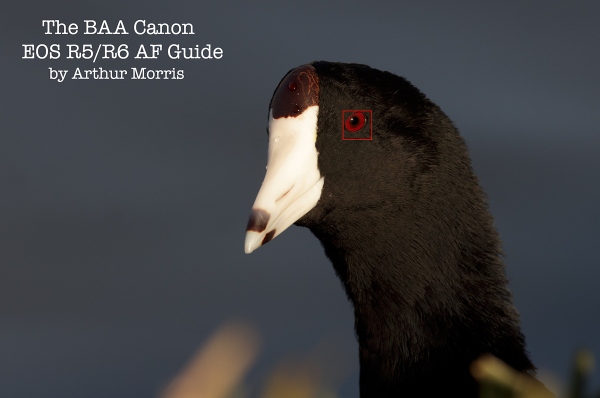


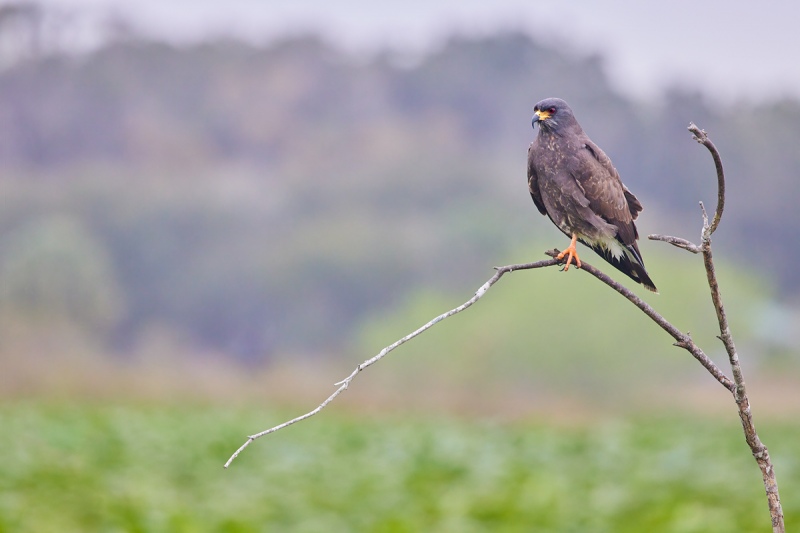
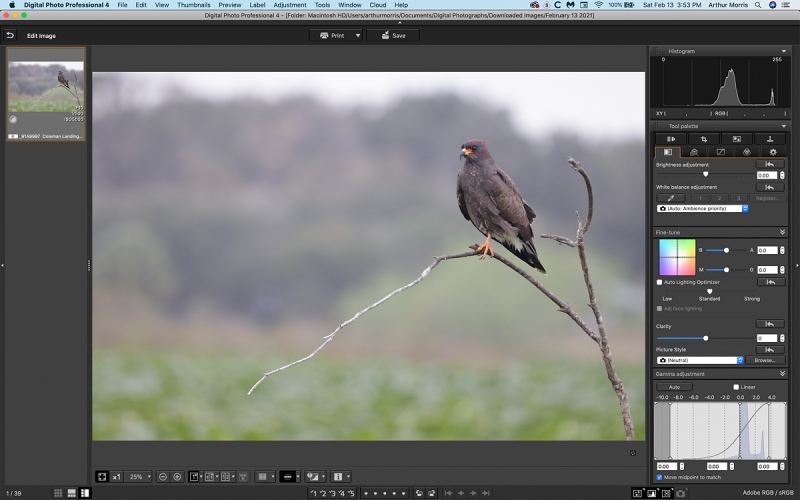
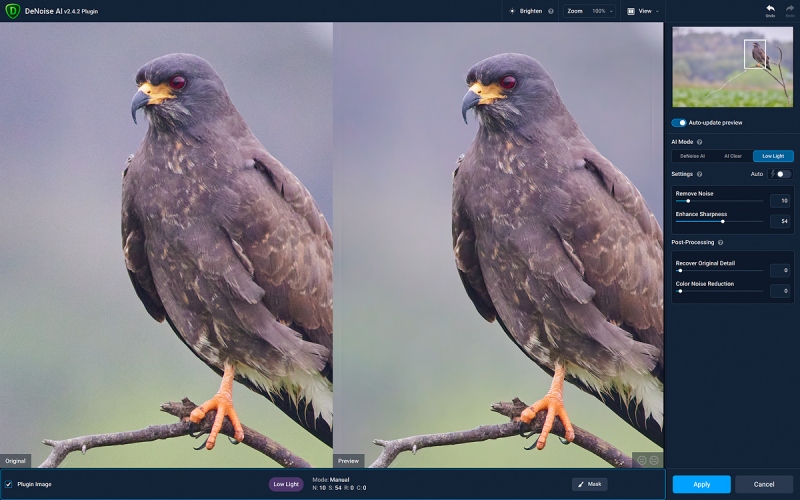
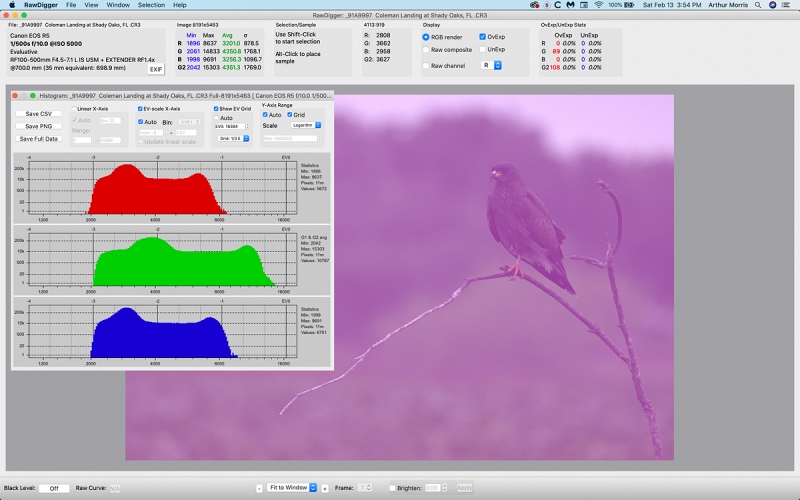













>> You lose the versatility of a zoom lens and are stuck at f/11. Most of the time I am at f/7.1. Being forced to f/11 would cost me or you 4 more clicks of ISO, 1 1/3 stops. <<
No question, but in bird photography we are more often than not at our maximum focal length, and, as you said, the RF 100-500mm lens at 500mm + 1.4x TC gives you 750mm @ f/10. That's a $3200 combo that weighs 3 1/2 pounds. Compare that to the RF 600mm f/11 ($700; 2 pounds) or the RF 800mm f/11 ($900; 2 3/4 pounds) — Canon is giving us some intriguing choices!
Steve, If you buy one of those two lenses please remember to use my links. Do know that I consider both of them to be gimmicks rather than tools for serious bird photographers.
with love, artie
ps: remember the old adage, you get what you pay for …
Great stuff, Art…
So the question is does a 100-400mm 5.6 with a 2x (getting you to f/11 800mm) work with the EOS to R converter? You may have to use the R 2x converter. Would this make a better rig if it works?
Yes, you could do that though in my experience the 1.4x paired with the 100-400 IS II (140-560) is a marginally acceptable choice especially for near objects while the 2x (200-800) is optically not very desirable. One would be better served by the more expensive and heavier 200-400 with the built in 1.4x or more appropriately a 500 or 600 f/4 prime.
I will chime in here. I would bet the the 100-400 with the 2X TC on a tripod, will be a lot sharper than most photographers. The problem is with keeping the gear still; the optics are fine. For static subjects, it will perform well.
And yes it works with the RF adapter.
See the proof below. I am sure it would do just as well with the R5.
with love, a
This image was created on South Plaza Island on July 25, Day 12 of the 2015 Galapagos Photo-Cruise. I used with the tripod mounted Canon EF 100-400mm f/4.5-5.6L IS II USM lens, the Canon Extender EF 2X III, and the Canon EOS-1D X. ISO 800. Evaluative metering -1/3 stop: 1/200 sec. at f/11. AWB.
Manual focus by necessity. Click on the image to see a larger version.
Female Land Iguana resting in the shade
I have some lovely images with the 100-400 is ii and 1.4x TC when the image fills the frame. Do any cropping and the image falls apart quickly unlike a 500 or 600 f/4 prime. My success with a 2x was significantly less.
As expected with moving subjects or with still subjects when not on a tripod. But there optics are not the problem.
with love, a
As a possessive pronoun, “its” does not have an apostrophe.
Thanks. My error was due to carelessness rather than lack of knowledge 🙂
Fixed with love, a
Speaking of the Canon RF 100-500m lens, you wrote:
>> With the prime lens wide open at f/7.1 at the long end, adding the teleconverter gets you to F/10. <<
It's interesting to note that Canon offers both 600mm and 800mm f/11 prime lenses for its R system, each for under $900. They are lightweight and collapsible for transport. These might be viable alternatives to the 100-500 + TC combo.
Hi Steve,
Or not … You lose the versatility of a zoom lens and are stuck at f/11. Most of the time I am at f/7.1. Being forced to f/11 would cost me or you 4 more clicks of ISO, 1 1/3 stops.
with love, artie